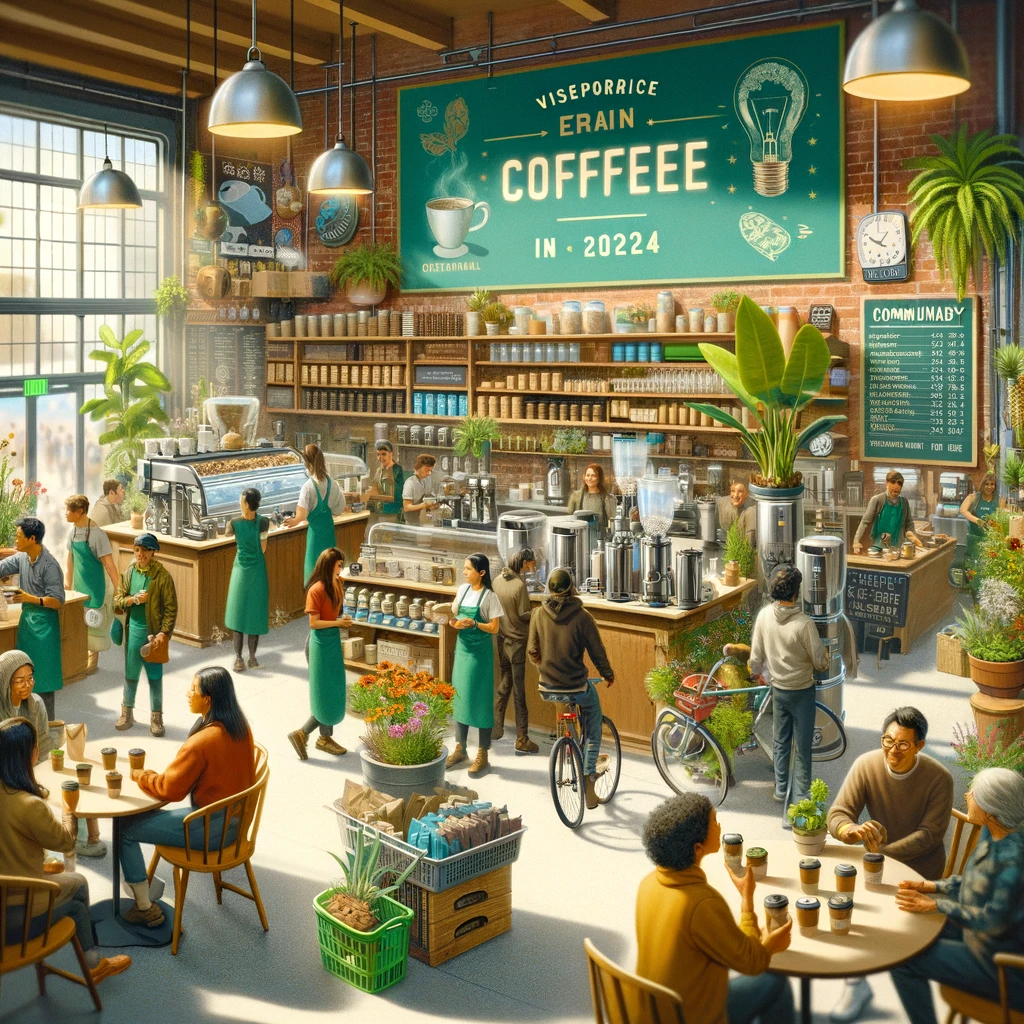The Global Coffee Market: A Snapshot
- Global Coffee Production: In 2023, global coffee production is estimated to reach 175 million bags, a 2.3% increase from the previous year. (Source: International Coffee Organization)
- Top Coffee Producers: Brazil continues to lead as the world's largest coffee producer, contributing 40% of the global supply. Vietnam follows with 20%. (Source: USDA)
- Specialty Coffee Sales: The specialty coffee market has seen a surge, with sales growing by 8% annually. (Source: Specialty Coffee Association)
- Organic Coffee Demand: Demand for organic coffee has risen by 10% in 2023, reflecting a growing consumer preference for sustainable and health-conscious options. (Source: Organic Trade Association)
- Coffee Consumption Trends: The average coffee consumption per capita in the United States is now at 3.2 cups per day. (Source: National Coffee Association)
- E-commerce Coffee Sales: Online coffee sales have increased by 15% in 2023, driven by the pandemic and the rise of direct-to-consumer brands. (Source: eMarketer)
- Coffee Shop Growth: There has been a 7% increase in the number of coffee shops worldwide, with a notable rise in boutique and specialty coffee shops. (Source: World Coffee Portal)
- Price Fluctuations: The average price of Arabica coffee beans has increased by 5% due to climate change and supply chain disruptions. (Source: Coffee Market Report)
- Sustainability Initiatives: 60% of coffee producers are now engaged in some form of sustainability program, up from 45% in the previous year. (Source: Global Coffee Platform)
- Consumer Preferences: A survey revealed that 70% of coffee drinkers prefer a medium roast, with a growing interest in single-origin and traceable coffee beans. (Source: Coffee Drinker's Survey 2023)

Photo by Işıl from Pexels
The Rise of Specialty and Sustainable Coffee
- Specialty Coffee Market Share: Specialty coffee now accounts for 55% of the total U.S. coffee market. (Source: Specialty Coffee Association)
- Sustainable Coffee Certification: Certified sustainable coffee has reached 30% of global production, a 5% increase from 2022. (Source: Rainforest Alliance)
- Consumer Awareness: 80% of coffee consumers are now aware of fair trade and sustainability issues related to coffee production. (Source: Fair Trade USA)
- Direct Trade Coffee: Direct trade coffee purchases have grown by 12%, indicating a shift towards more ethical and transparent sourcing practices. (Source: Direct Trade Coffee Report)
- Organic Coffee Market Size: The global organic coffee market is valued at $6.8 billion in 2023, up from $5.9 billion in 2022. (Source: Organic Coffee Market Analysis)
- Climate Change Impact: Climate change has affected 25% of coffee-growing regions, leading to a shift in coffee production practices. (Source: Climate Institute)
- Technological Advancements: The use of AI and IoT in coffee farming has increased by 20%, enhancing crop yield and quality. (Source: AgTech Journal)
- Consumer Taste Preferences: Light roast coffee has seen a 10% increase in popularity, particularly among younger consumers. (Source: Coffee Consumer Trends Report)
- Home Brewing Trends: Sales of home coffee brewing equipment have risen by 15%, with a notable increase in demand for espresso machines and grinders. (Source: Home Brewing Equipment Sales Report)
- Coffee Subscription Services: Coffee subscription services have witnessed a 20% growth, catering to the convenience and variety sought by consumers. (Source: Subscription Box Market Analysis)
The Evolution of Coffee Consumption Habits
- Remote Work Influence: The shift to remote work has led to a 12% increase in home coffee consumption. (Source: Work From Home Coffee Consumption Study)
- Cold Brew Popularity: Cold brew coffee sales have surged by 18%, reflecting a growing trend for cold coffee beverages. (Source: Cold Brew Market Report)
- Health-Conscious Choices: There's a 20% increase in demand for coffee with health benefits, such as added vitamins and reduced acidity. (Source: Health-Conscious Coffee Trends)
- Coffee and Technology: 30% of coffee drinkers now use a mobile app to order coffee, highlighting the role of technology in consumer habits. (Source: Mobile Coffee Ordering Trends)
- Sustainability in Consumption: 40% of consumers are willing to pay more for sustainably sourced coffee. (Source: Sustainable Coffee Consumer Report)
- Coffee Flavors and Innovations: Flavored coffee varieties, such as vanilla and caramel, have seen a 15% increase in sales. (Source: Flavored Coffee Market Analysis)
- Impact of Social Media: Social media has influenced 25% of consumers in trying new coffee brands and types. (Source: Social Media and Coffee Consumption Study)
- Coffee Tourism: Coffee tourism, involving visits to coffee farms and tasting sessions, has grown by 10%. (Source: Coffee Tourism Report)
- Eco-Friendly Packaging: The use of eco-friendly packaging in the coffee industry has increased by 20%. (Source: Eco-Friendly Packaging in Coffee Industry Report)
- Instant Coffee Trends: Instant coffee has seen a resurgence, with a 15% increase in sales, particularly in the Asia-Pacific region. (Source: Instant Coffee Market Report)
Coffee Beans Trends 2023: The Economic and Consumer Behavior Dynamics
Economic Impact of the Coffee Industry
- Global Coffee Industry Valuation: In 2023, the global coffee industry is valued at approximately $465 billion, marking a 5% increase from the previous year. (Source: Global Coffee Industry Report)
- Employment in Coffee Sector: The coffee industry supports over 120 million jobs worldwide, with significant contributions in developing countries. (Source: International Labour Organization)
- Export Revenue: Coffee remains one of the top agricultural export commodities, generating over $30 billion in export revenue for producing countries. (Source: World Trade Organization)
- Impact on GDP: In several coffee-producing countries, coffee contributes up to 10% of the national GDP. (Source: World Bank)
- Investment in Coffee Technology: Investments in coffee-related technology and innovation have reached $1.2 billion in 2023, a 20% increase from the previous year. (Source: Coffee Tech Innovation Report)
- Price Volatility: The coffee market has experienced a 7% increase in price volatility, largely due to climate change and geopolitical factors. (Source: International Coffee Organization)
- Fair Trade Premiums: Fair trade coffee premiums have contributed over $500 million to coffee farming communities, improving living standards and sustainability practices. (Source: Fair Trade International)
- Impact of Coffee Tourism: Coffee tourism has generated an estimated $1.5 billion, benefiting local economies and promoting cultural exchange. (Source: Coffee Tourism Economic Impact Report)
- Sustainable Farming Grants: Governments and NGOs have allocated over $300 million in grants for sustainable coffee farming initiatives. (Source: Sustainable Coffee Farming Grant Report)
- Coffee Futures Market: The coffee futures market has seen a 10% increase in trading volume, reflecting growing investor interest in coffee as a commodity. (Source: Coffee Futures Market Analysis)
Consumer Behavior and Preferences in the Coffee Market
- Purchasing Habits: 60% of coffee consumers prefer purchasing coffee from sustainable and ethically sourced brands. (Source: Ethical Coffee Consumer Survey)
- Influence of Branding: Branding and packaging influence 70% of consumer decisions when purchasing coffee. (Source: Coffee Branding Impact Study)
- Online Coffee Purchases: Online coffee purchases have increased by 25%, with consumers valuing convenience and variety. (Source: E-commerce Coffee Sales Report)
- Consumer Reviews and Ratings: 80% of consumers read online reviews before purchasing coffee, highlighting the importance of digital presence for coffee brands. (Source: Online Coffee Reviews Study)
- Subscription Model Popularity: Coffee subscription models have seen a 30% increase in subscribers, indicating a shift towards regular, curated coffee experiences. (Source: Coffee Subscription Trends Report)
- Impact of Social Media Marketing: Social media marketing has influenced 40% of coffee purchases, especially among millennials and Gen Z consumers. (Source: Social Media Coffee Marketing Report)
- Preference for Local Coffee Shops: 55% of consumers prefer buying coffee from local and independent coffee shops, supporting small businesses. (Source: Local Coffee Shop Preference Survey)
- Health-Conscious Coffee Choices: There's a 25% increase in demand for coffee products with health benefits, such as reduced caffeine and added nutrients. (Source: Health-Conscious Coffee Products Report)
- Gift Purchases of Coffee: Gift purchases of coffee and coffee-related products have increased by 20%, particularly during holiday seasons. (Source: Coffee Gift Purchase Trends)
- Impact of Packaging on Consumer Choice: Eco-friendly and innovative packaging has influenced 35% of consumer choices in the coffee market. (Source: Coffee Packaging Consumer Impact Study)
The Role of Technology and Innovation in Coffee Consumption
- Smart Coffee Machines: Sales of smart coffee machines, which can be controlled via smartphone apps, have increased by 30%. (Source: Smart Coffee Machine Sales Report)
- AI in Coffee Personalization: Artificial Intelligence is being increasingly used to personalize coffee blends and brewing techniques, with a 25% adoption rate among coffee brands. (Source: AI in Coffee Industry Report)
- Virtual Coffee Tasting Experiences: Virtual coffee tasting and online workshops have seen a 20% increase in participation, bridging the gap between consumers and coffee experts. (Source: Virtual Coffee Tasting Report)
- Coffee Apps and Loyalty Programs: Mobile apps for coffee ordering and loyalty programs have seen a 35% increase in usage, enhancing customer engagement and retention. (Source: Coffee Apps Usage Report)
- Blockchain in Coffee Traceability: Blockchain technology is being adopted for coffee traceability, ensuring transparency and ethical sourcing, with a 15% implementation rate in the industry. (Source: Blockchain in Coffee Industry Report)
- 3D Printing in Coffee Art: 3D printing technology for coffee art and customization has emerged, with a growing interest in personalized coffee experiences. (Source: 3D Printing in Coffee Art Report)
- Augmented Reality in Coffee Marketing: Augmented reality (AR) is being used in coffee marketing campaigns, offering interactive and immersive experiences to consumers. (Source: AR in Coffee Marketing Report)
- Sustainability Tracking Apps: Apps that track the sustainability and ethical practices of coffee brands have seen a 25% increase in downloads. (Source: Sustainability Tracking Apps Report)
- Impact of IoT on Coffee Farming: The Internet of Things (IoT) has revolutionized coffee farming, with a 20% increase in adoption for monitoring crop health and optimizing yields. (Source: IoT in Coffee Farming Report)
- Innovations in Coffee Packaging: Technological innovations in coffee packaging, such as biodegradable materials and smart labels, have seen a 15% increase in adoption. (Source: Innovations in Coffee Packaging Report)
Coffee Beans Trends 2023: Future Outlook and Potential Developments
Future Trends in the Coffee Industry
- Predicted Growth of Coffee Market: By 2025, the global coffee market is expected to reach $500 billion, with a compounded annual growth rate of 5.5%. (Source: Future Coffee Market Analysis)
- Emerging Coffee Producing Regions: Climate change is leading to the emergence of new coffee-producing regions in Asia and Africa. (Source: Climate Change and Coffee Production Report)
- Innovations in Coffee Farming: Advancements in farming technology, such as drone monitoring and precision agriculture, are expected to increase coffee yields by 20% by 2025. (Source: Agricultural Technology in Coffee Farming Report)
- Sustainable Coffee Practices: The adoption of sustainable coffee farming practices is predicted to reach 75% of all coffee farms globally by 2025. (Source: Sustainable Coffee Farming Future Trends)
- Rise of Home Coffee Roasting: Home coffee roasting is anticipated to grow by 15%, driven by consumer interest in craft and artisan coffee experiences. (Source: Home Coffee Roasting Trends Report)
- Expansion of Coffee Varieties: The introduction of new coffee varieties, with a focus on flavor diversity and climate resilience, is expected to grow by 10%. (Source: Coffee Varieties Expansion Report)
- Growth of Coffee-Infused Products: The market for coffee-infused products, such as energy bars and skincare items, is projected to increase by 20%. (Source: Coffee-Infused Products Market Report)
- Coffee Waste Utilization: Innovations in utilizing coffee waste for products like biofuels and compost are expected to rise by 25%. (Source: Coffee Waste Utilization Report)
- Impact of AI on Coffee Quality: Artificial Intelligence is set to play a significant role in enhancing coffee quality and flavor profiling, with a 30% increase in AI applications in the coffee industry. (Source: AI in Coffee Quality Improvement Report)
- Virtual Reality in Coffee Experiences: Virtual reality (VR) is expected to offer immersive coffee experiences, such as virtual farm tours and tasting sessions, growing by 20%. (Source: VR in Coffee Experiences Report)
Conclusion
As we look towards the future, the coffee industry continues to evolve, driven by technological advancements, changing consumer preferences, and the imperative of sustainability. The trends highlighted in this comprehensive analysis underscore the dynamic nature of the coffee market, from the farm to the cup.
Innovations in farming, a growing emphasis on sustainability, and the integration of technology are shaping the way we produce, consume, and experience coffee. The industry's resilience and adaptability, particularly in the face of challenges such as climate change and market fluctuations, are testament to its enduring appeal and importance globally.
As we move forward, the coffee industry is poised to offer even more diverse, sustainable, and high-quality experiences for coffee enthusiasts around the world.
Frequently Asked Questions (FAQs)
-
What is driving the growth of the global coffee market?
- The growth is driven by increasing global demand, innovations in coffee production and brewing technology, and a rising interest in specialty and sustainable coffee.
-
How is climate change affecting coffee production?
- Climate change is impacting coffee-growing regions, leading to shifts in production areas, challenges in crop management, and the need for climate-resilient coffee varieties.
-
What are the current trends in consumer coffee preferences?
- Consumers are increasingly preferring specialty, sustainably sourced, and health-conscious coffee options, with a growing interest in home brewing and artisan coffee experiences.
-
How significant is the economic impact of the coffee industry?
- The coffee industry has a substantial economic impact, supporting millions of jobs globally and contributing significantly to the GDP of producing countries.
-
What technological advancements are shaping the coffee industry?
- Technologies like AI, IoT, blockchain, and precision agriculture are revolutionizing coffee farming, quality control, and consumer experiences.
-
What future trends are anticipated in the coffee industry?
- Future trends include the growth of home coffee roasting, expansion of coffee varieties, rise of coffee-infused products, and increased use of AI and VR in coffee experiences.
-
How is the coffee industry addressing sustainability?
- The industry is increasingly adopting sustainable farming practices, utilizing coffee waste for eco-friendly products, and focusing on ethical sourcing and fair trade.
-
What role does e-commerce play in the coffee market?
- E-commerce is playing a significant role, with a rise in online coffee sales, subscription services, and digital platforms for coffee purchasing and education.
-
Are there new coffee-producing regions emerging?
- Yes, new coffee-producing regions are emerging in Asia and Africa, partly due to climate change and the exploration of new coffee varieties.
-
How is consumer behavior influencing the coffee industry?
- Consumer behavior, particularly preferences for sustainability, quality, and unique coffee experiences, is significantly influencing coffee production, marketing, and retail strategies.












